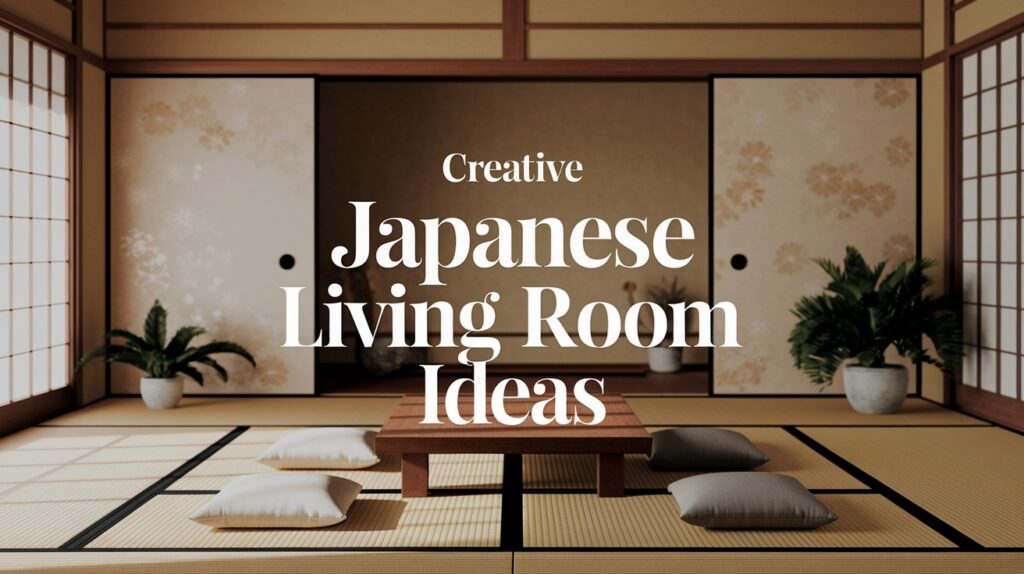Japanese design philosophy centers on three fundamental principles: simplicity, nature, and harmony.
These timeless concepts create spaces that feel calm, balanced, and deeply connected to the natural world.
In recent years, Japanese-style living rooms have gained tremendous popularity as homeowners seek refuge from cluttered, chaotic environments.
The appeal lies in the philosophy’s ability to transform any space into a tranquil sanctuary.
Clean lines, natural materials, and thoughtful placement of each element work together to create rooms that breathe with serenity.
These 13 innovative concepts showcase how traditional Japanese aesthetics can be adapted for modern homes, offering fresh perspectives on creating peaceful, functional living spaces that promote mindfulness and well-being.
List of 13 Creative Japanese Living Room Ideas
This collection features 13 distinct approaches to creating Japanese-inspired living spaces. Each idea combines traditional design elements with modern functionality, offering practical ways to transform your room into a serene, harmonious environment that reflects authentic Japanese aesthetics.
1. Minimalist Zen Retreat
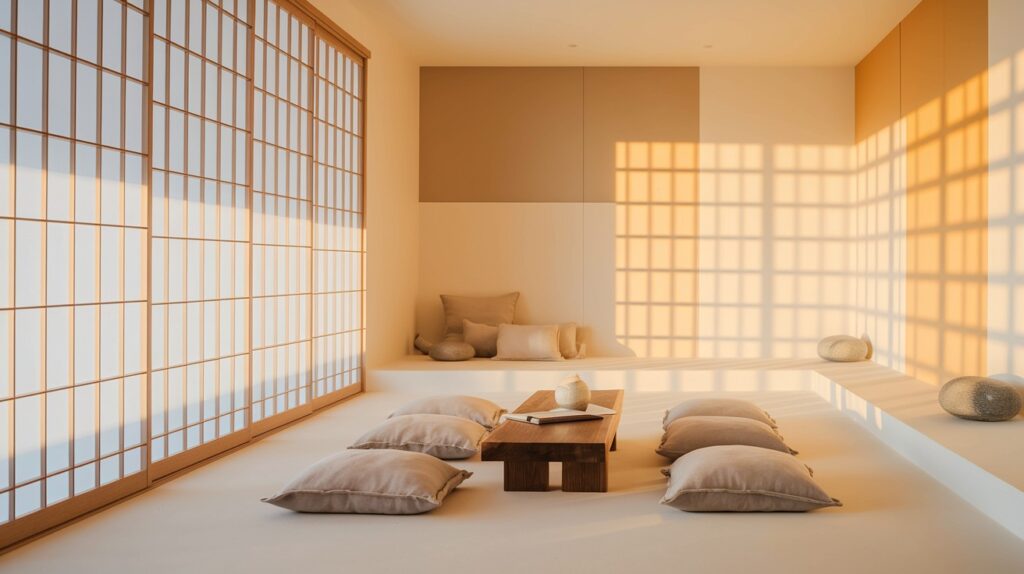
Creating a minimalist zen retreat begins with removing excess items and keeping only essential furniture pieces.
This approach emphasizes clean lines and open space, allowing the room to breathe naturally.
Choose calming neutral tones like soft whites, warm beiges, and gentle grays to establish a peaceful foundation.
Incorporate organic textures through natural materials such as linen cushions, wooden surfaces, and stone accents.
The goal is to create an environment where every element serves a purpose while contributing to the overall sense of tranquility and balance.
2. Traditional Tatami Room
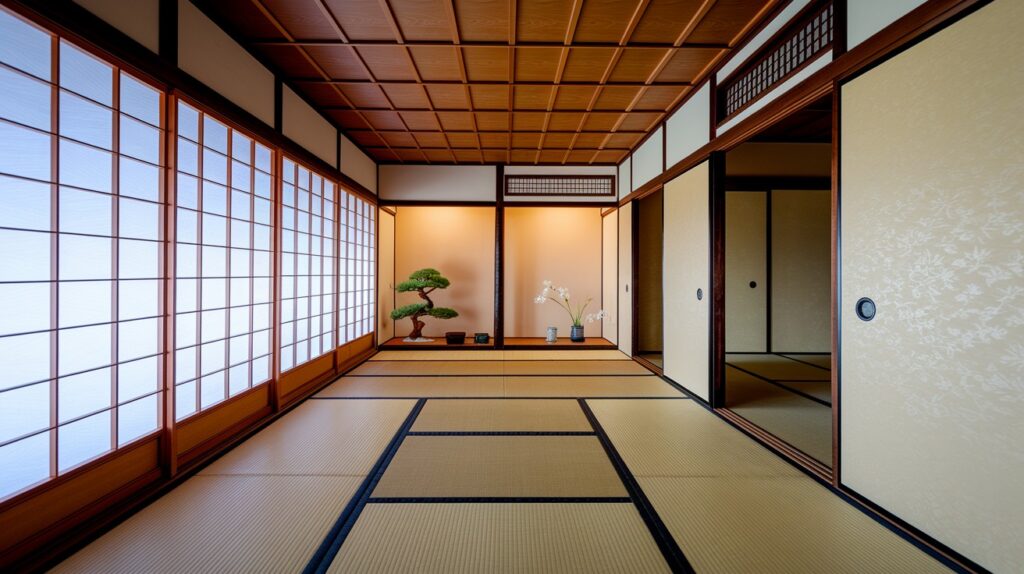
Traditional tatami rooms showcase authentic Japanese flooring that defines classic interior design.
These natural grass mats provide both comfort and cultural significance, creating a foundation that connects your space to centuries of tradition.
Combine tatami flooring with sliding shoji screens to achieve an immersive authentic feel.
The screens filter light beautifully while maintaining privacy, and their wooden frames complement the natural tones of the tatami mats perfectly.
3. Modern Kotatsu Lounge
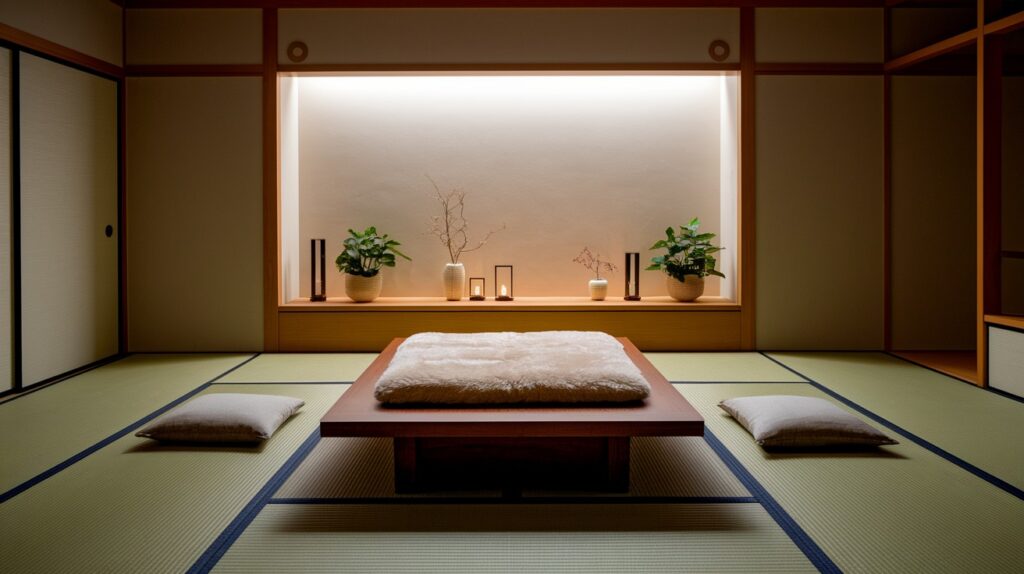
A modern kotatsu lounge brings together comfort and functionality through a heated table setup that serves as the room’s focal point.
Integrate contemporary seating options around the kotatsu to create a space that works for both relaxation and social gatherings.
This setup proves particularly valuable during winter months, providing warmth while encouraging intimate conversations and relaxed lounging sessions with family and friends.
4. Nature-Infused Design

Nature-infused design brings outdoor elements inside to create a living connection with the natural world.
Incorporate bonsai trees, bamboo plants, and small indoor rock gardens to establish this organic atmosphere.
Maximize natural light through strategic window placement and add gentle water features like small fountains or shallow bowls.
These elements work together to create a space that feels alive and constantly changing with the seasons.
5. Shoji Screen Dividers
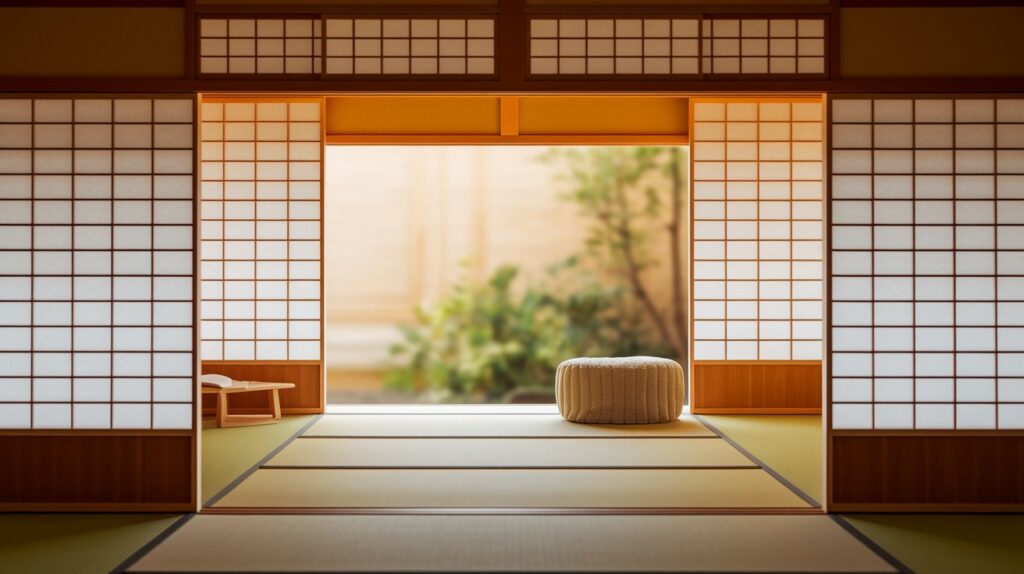
Shoji screen dividers offer light-filled privacy solutions that create separation while maintaining openness throughout your space.
These translucent panels allow natural light to flow freely while defining distinct areas within open-plan layouts.
Use them to create reading nooks, meditation corners, or simply to add visual interest to larger rooms.
Their wooden frames and paper panels bring authentic Japanese craftsmanship into modern living spaces.
6. Chabudai Dining Nook

A chabudai dining nook features a low table with floor seating that creates an intimate space perfect for tea ceremonies or small meals.
Add zabuton cushions around the table to provide comfortable seating while maintaining the traditional aesthetic.
This setup encourages slower, more mindful dining experiences and creates opportunities for meaningful conversations in a relaxed, grounded setting.
7. Artistic Tokonoma Display
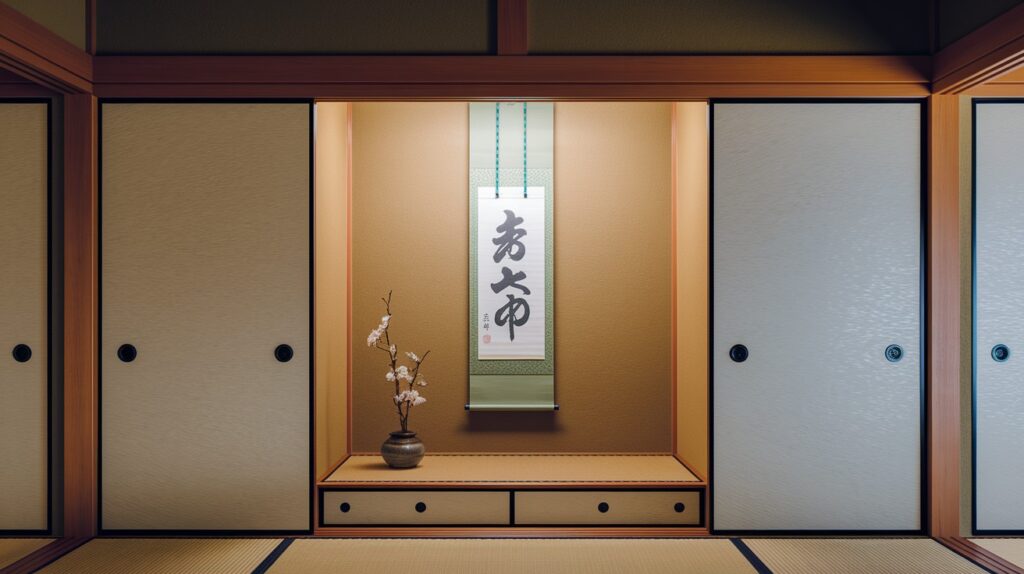
An artistic tokonoma display utilizes a recessed alcove to showcase meaningful decor such as scrolls or ikebana arrangements.
This traditional feature serves as a focal point for seasonal displays, allowing you to change the exhibit throughout the year for a dynamic, evolving look.
The simplicity of the alcove frame draws attention to the displayed items while maintaining the room’s overall sense of balance.
8. Contemporary Fusion Style
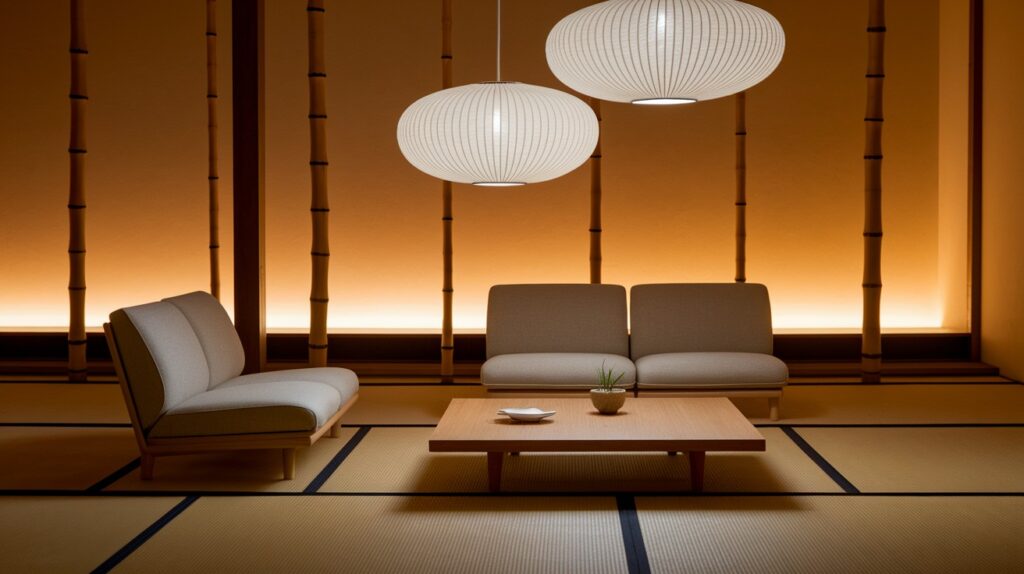
Contemporary fusion style blends Japanese aesthetics with modern minimalism to create spaces that feel both current and timeless.
Mix clean-lined furniture with traditional elements like washi paper lamps to achieve this balanced approach.
Use sleek materials combined with natural finishes to create contrast while maintaining harmony throughout the space.
9. Floor Seating Meditation Zone

A floor seating meditation zone creates a calm corner dedicated to reflection and mindfulness practices.
Include tatami or woven mats as the foundation, along with incense holders and soft lighting to establish the proper atmosphere.
This designated area proves ideal for meditation sessions, tea drinking, or quiet reading, providing a retreat within your own home.
10. Noren Curtain Accents
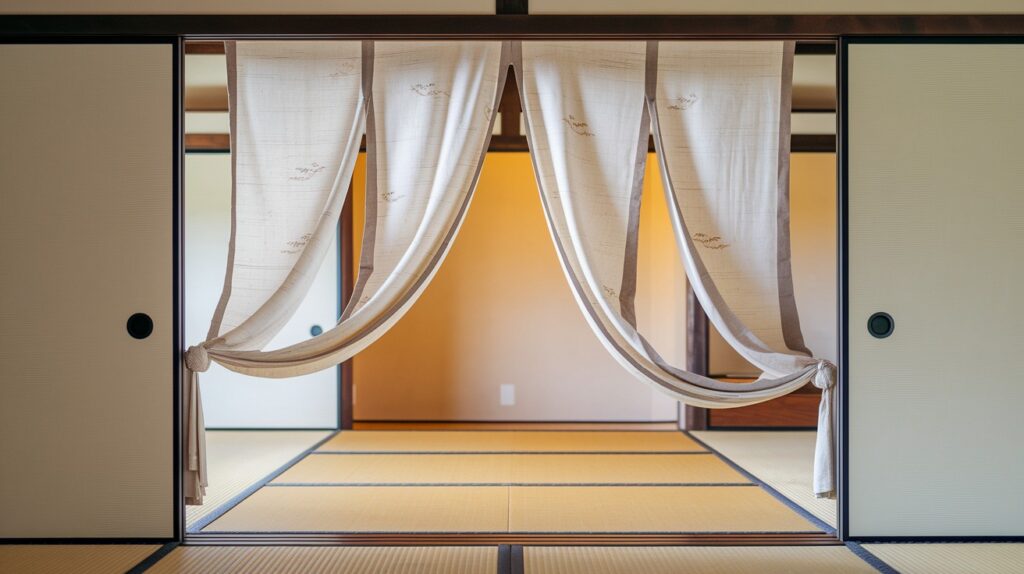
Noren curtain accents add soft partitions through fabric panels that bring texture and cultural detail to your space.
Hang these traditional curtains in doorways or windows to create gentle boundaries while maintaining flow between areas.
The fabric panels move softly with air currents, adding subtle movement and visual interest to static room layouts.
11. Washi Lighting Atmosphere

Washi lighting creates atmosphere through handmade paper lanterns and pendant lights that provide soft, diffused illumination.
These traditional paper fixtures cast warm, gentle light that transforms the room’s mood, especially during evening hours.
The handcrafted quality of washi paper adds authentic texture while filtering harsh electric lighting into something more natural and soothing.
12. Wall Art and Calligraphy
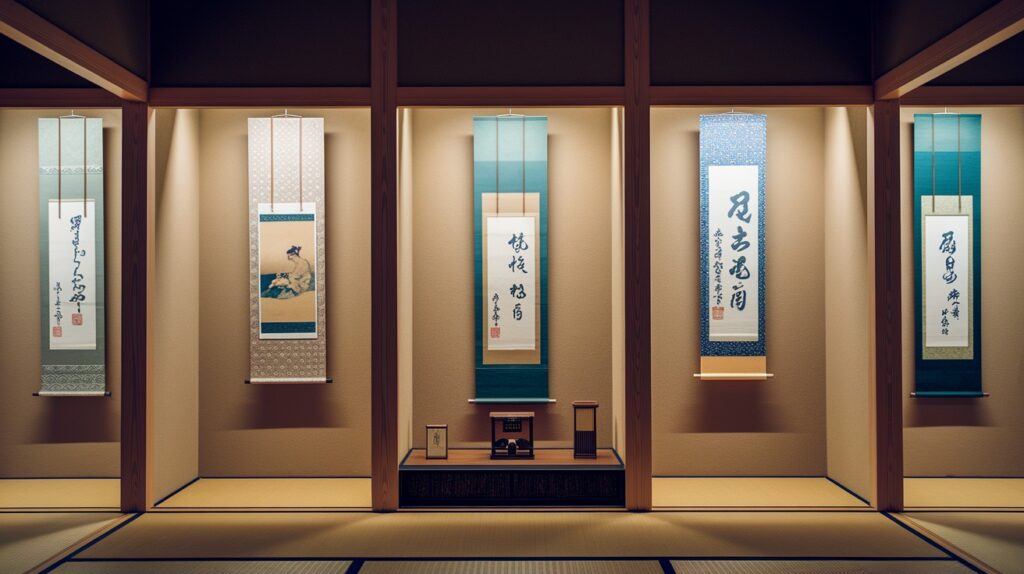
Wall art and calligraphy transform plain surfaces with traditional Japanese artistic elements.
Display ukiyo-e prints, calligraphy scrolls, or vertical kakejiku to add cultural depth to your space.
Keep framing minimal and clean to maintain authenticity while allowing the artwork itself to serve as the focal point against neutral wall colors.
13. Rustic Wood and Natural Elements

Rustic wood and natural elements embrace raw materials to create grounded, earthy atmospheres.
Use unfinished or lightly stained wood furniture to showcase natural grain patterns and textures.
Accent these wooden pieces with stone elements, ceramic vessels, or linen textiles to build layers of natural materials that work together harmoniously throughout the space.
Conclusion
These 13 creative approaches demonstrate how Japanese design principles can transform any living space into a sanctuary of peace and functionality. From minimalist zen retreats to traditional tatami rooms, each concept offers unique ways to incorporate authentic elements while maintaining modern practicality. The beauty lies in combining multiple ideas to create a personalized space that reflects your lifestyle and preferences.
Consider mixing floor seating areas with nature-infused displays, or pairing shoji screens with contemporary fusion elements. The key is selecting concepts that resonate with your daily routines and aesthetic preferences. Remember to keep balance and serenity at the heart of your space, allowing these timeless principles to guide every design decision you make.
Frequently Asked Questions
What are the key principles of Japanese living room design?
Japanese living room design focuses on three main principles: simplicity, natural harmony, and functional balance. These concepts create peaceful spaces that emphasize clean lines, natural materials, and thoughtful arrangement of essential elements.
How can I create a Japanese-style living room on a budget?
Start with decluttering your existing space and adding simple elements like floor cushions, bamboo plants, or paper lanterns. Focus on neutral colors and remove excess decorations to achieve the minimalist aesthetic without major renovations.
What furniture is essential for a Japanese living room?
Essential furniture includes low seating options like floor cushions or a kotatsu table, natural wood storage solutions, and minimal decor pieces. The goal is to keep furniture close to the ground and choose pieces that serve multiple purposes.
Can I mix Japanese design with other interior styles?
Yes, Japanese design principles work well with modern minimalism, Scandinavian style, and contemporary aesthetics. The key is maintaining balance and avoiding overly ornate elements that conflict with the clean, simple Japanese approach.
What plants work best in Japanese-inspired living rooms?
Bonsai trees, bamboo plants, and simple green plants in ceramic pots work perfectly for Japanese interiors. Choose plants with clean lines and avoid overly colorful or tropical varieties that might disrupt the calm, natural atmosphere.

